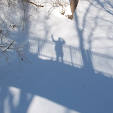The workforce is an all-volunteer workforce. Many are retired people who want to do something socially useful. Most are from the DeMotte and Wheatfield area with some commuting from Lake and Porter Counties. Each volunteer is assigned to a particular area, such as the wood shop, the paint shop, or the metal working shop. Seeing how the work was organized reminded me of the CDC Resources workshop, which breaks jobs down into simple steps.
Part of each PET is made of wood. Most of the wood is bought locally at cost and cut. There is no measuring in the production process. Everything is done with templates. In the picture below you can see some of the sizes that are used. the gray boards are the templates. They are placed on the table and the uncut board is butted up against it. Then a cut is made with a radial arm saw giving the exact size needed. To make a different piece, a different template is used.
The pieces are assembled with screws and the screw holes are drilled using a template similar to the one shown below. The piece is either the seat or the back of the seat.
Pieces in various states of assembly are shown below along with one finished piece that has been painted, another task that has its own special crew.
The vehicles have cushions that are made at the facility. The cushions start as sheets of foam rubber which are cut to size and then put into a cloth enclosure.
The frame of the PET is made from steel and much of the frame is constructed at the DeMotte facility. First the steel is cut to the proper lengths. As with the wooden pieces, there are templates used for cutting so each piece has the proper length.
After the metal is cut, it is buffered and holes are drilled. A before and after look is shown below.
Sparks fly in the welding area.
The fork that holds the front wheel is not produced at DeMotte but rather in Michigan. It has intricate welds and I think it is done with a robotic welding machine.
The frame that is made in DeMotte is then attached to the fork to complete the frame.
The wheels are made in China. They are solid so flat tires are not a problem the users will ever have to worry about. In the picture below you can see the painting area.
After the vehicles are assembled, they are partially disassembled to be packed. In this section of the building you can see some boxes of pull PETs that are used for small children. There are three models of PETs produced in the 26 PET facilities throughout the United States, the pull PETs, PETs for children, and adult PETs. The DeMotte facility only produced the adult PETs. The pull PETs were produced in a Michigan facility.
The boxed PETs will be put into a container and the container will travel to Africa on a ship. Also included in the container are various other things, such as crutches and walkers. There is a mattress and a recliner on the pile. One of the volunteers in Swaziland has decided to stay there and so some comforts of home were being shipped to her. The PETs in the foreground need to be disassembled and packed.
When they are packed, this is what the box looks like. The jugs serve two purposes. They are packing material to prevent shifting of contents but when the box is unpacked they will be used as water jugs in Swaziland. Some of them come from a car dealership. They had contained a fluid that will completely evaporate so they can be used for water--I think it was windshield wiper fluid but my memory is a bit fuzzy on that.
Over the years the look of vehicles has changed. An older model is in the back and the latest is in the front. As users and producers figure out ways to make them better, the changes are incorporated into the design plans.
If you want your own PET, you are out of luck. The US has too many regulations and trial lawyers to allow distribution in the U.S.
The DeMotte factory produces six vehicles a week. Most of the volunteer work is done three mornings per week. The facility could easily produce double that production, but the cost of materials is about $250 per vehicle and it is that cost that limits production. Because the vehicles are given away, the cost must be covered by donations. If you or a group of people would like to make life better from someone whom you will never meet, consider donating.
The main PET website is here. The DeMotte website is here. Both have videos. The second video on the DeMotte website shows production in the DeMotte workshop at the end of the video and the person who took the time to give us a wonderful tour is in that video, working in the metal area.
Before we returned to Rensselaer, we stopped by a very different wood working business in the DeMotte area. The owner makes very intricate and detailed wooden models of vehicles. I did not take any pictures but you can see what he produces from his website, which gets many more hits a day than this blog or any other website I maintain.

















1 comment:
Thanks so much for the tour. I appreciate the all-volunteer work that is being done there.
Post a Comment